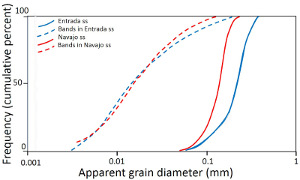| |||||||
|
|
|||||||
|
|
|||||||
| Grain Size Distribution in Shear Bands | |||||||
|
Shear bands formed by cataclastic mechanism display a significant decrease in grain size within the bands with respect to the initial grain size of the undeformed matrix and poor sorting (Figure 1). These changes associated with the comminution of grains result in a shift to smaller grain size as well as a broader range of grain size distribution within natural shear bands in sandstone (Engelder, 1974; Aydin, 1978; Aydin and Johnson, 1978). Similar trends are observed in shear bands produced in the laboratory (Mair et al., 2000) as shown in Figure 2. The grain size distribution plot in Figure 2 demonstrates also the progressive change of the grain size distribution as a function of the axial strain (up to 11.2%) to which the sample was subjected to. Shipton and Cowie (2001) characterized shear band zones and particularly grain size adjacent to slip surfaces and suggested a lower limit of grain size adjacent to them. Additional information on grain size reduction in granular rock and sediments related to shear band can be found in experimental studies such as Marone and Scholz (1989) and Crawford (1998). | |||||||
| Reference: |
|||||||
| Aydin, A., Johnson, A.M., 1978 Aydin, A., 1978 Coward, M.P., Daltaban, T.S., Johnson, H., 1998 Crawford, B.R., 1998 Engelder, T., 1974 Mair, K., Main, I., Elphick, S., 2000 Marone, C., Scholz, C.H., 1989 Shipton, Z.K., Cowie, P.A., 2001 |
|||||||
|
Readme | About Us | Acknowledgement | How to Cite | Terms of Use | Ⓒ Rock Fracture Knowledgebase |
|||||||

